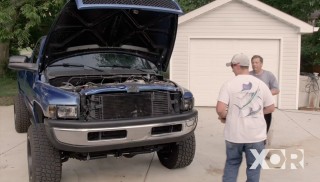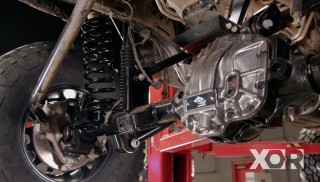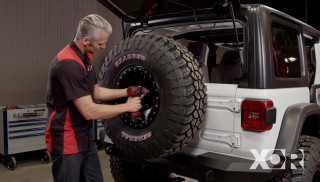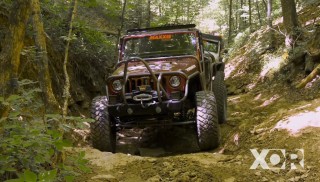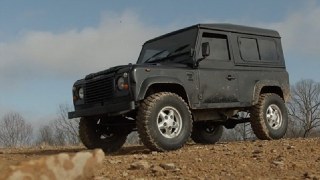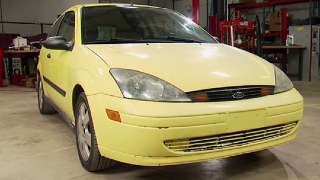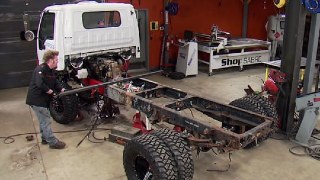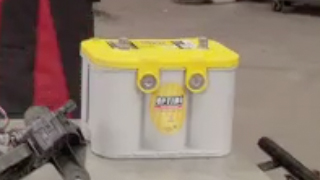XOR - Xtreme Off-Road Builds
Want more content like this?
Join the PowerNation Email NewsletterParts Used In This Episode
Ford Performance Parts
CONTROL PACK 2015-2017 COYOTE 5.0L WITH AUTOMATIC TRANSMISSION
Lincoln Electric
Lincoln Electric is the official welding supplier to XOR
Matco Tools
MATCO Tools are the Official Tool Supplier to XOR
The Industrial Depot
Tools, Hardware, and Shop Supplies
Episode Transcript
(Narrator)>> Today on XOR our Ford Ranger gets electrified. Plus we add some curves to the front end, and the interior, well it's getting a bunch of racing goodies, right now on XOR.
(Eliza)>> We're getting so close to firing up the Pre-Runner and taking it out for some much needed dirt therapy, but before we can get horsepower to the wheels we've got to power up our computer and fuel injection system.
(Jeremy)>> So today we're gonna be working on one of the most important and time consuming processes of this whole project, and that's well wiring. Now I know it's not the most exciting thing to do in the world but once we hear our engine fire up and our whole chassis comes to life we know that all this hard work is definitely worth it. Now we've got a whole lot to hook up underneath the hood and inside the cab, but we're gonna need some parts to pull that off. Well Ford Performance sent us their control pack. Now this talks directly to our Coyote and it plugs right in. We also went to Summit Racing dot com and picked up one of their switch plates and a battery box, and Optima Batteries sent us a yellow top battery. Now we're gonna think real positively about this whole process and start with the battery box.
I'll mark the location of the grommets, and use a step drill to drill the holes out to the final size. Our truck will see some major vibrations and flexing. I'll install rubber grommets. That way the power cables won't get cut and arch out on the cab. The battery box is made of thick steel. So it's plenty rigid, and our Optima battery is made to fit right in it.
We're gonna take a unique approach and run our battery cables directly through the cab because that's where they're gonna be hooked up anyway.
(Eliza)>> Just in case something happens Jeremy and I want to be able to kill the power to the whole truck completely. So we're gonna go ahead and get this kill switch installed.
The cutoff switch has a rectangular protrusion that I need to make a slot for. I'll use the width of the protrusion and a straight edge to mark the area that I need to cut out. Since this is a pretty thin gauge aluminum sheet I can use a series of snips to cut out the slot for the switch.
I've Cleco'ed the sheets so that we can mock up the location of the cutoff switch. And I've used Philips fasteners to secure it all in.
(Jeremy)>> Let me paint you guys a picture. You've been out on the trails all day long and you've stopped to grab a bite to eat. Well when you jump back in your truck and hit that key nothing happens. Zero, nada. There ain't nothing worse. Well to keep that from happening, and especially on the electrical side of it, we're gonna soldering all of our vital connections. First we'll strip the wire back about a half an inch so it'll fit inside the connector. Now you guys are probably wondering what these are. Well these are solder plugs. They make soldering your connections a whole lot easier. Using a butane torch we'll heat the copper up just enough to melt the solder plug, and then just insert the wire into the end. And the same process goes for the battery side. Well now that we have the ends soldered on our cables we're gonna move on to the alternator and our high torque mini starter that we got from Summit Racing dot com. Now I'm gonna show you guys a special way to tie both of these systems and the kill switch completely together. It may be close quarters but that's why we chose a mini starter.
Next we'll move on to the alternator. To make our kill switch work and to shut power off to the entire truck we're gonna hook the alternator charger wiring up to the starter. That way when we kill the power to the starter it's gonna kill the power to the whole truck. All we need to do now is connect the battery and the starter to the cutoff switch.
Now we needed a way to control the fuel injection and ignition system on our Coyote. What better way to do that than with a harness and a computer from Ford Performance.
(Eliza)>> Yep, this pedal talks to our p-c-m, and without it our Coyote would not operate. And it's a drive by wire system, which means no cable. Alright Jeremy I think I have a better shot at getting this in there.
(Jeremy)>> You can go for it. I'm going on a coffee break.
(Eliza)>> We're not just playing pin the tail on the donkey with this cable less pedal. We had already pre-measured the best location of the pedal since Jeremy is well over a foot taller than I am. The pedal is a quick install with three bolts and a quick connection of the harness.
(Narrator)>> Up next, how can you add bumpers and a skid plate to your rig? We'll show you how on XOR.
(Eliza)>> This came out awesome.
(Jeremy)>> Yeah that should work out really well. Hey guys, welcome back. Well I got a little sick of being in the cab. So I stepped out to grab a little bit of fresh air. Since I'm up front anyways we're gonna go ahead and build a custom bumper, add a skid plate, and then throw a whole bunch of lights on it. And when it comes to the bumper the simplest design is gonna be the easiest design. So we're gonna build it out of some tubing, and that doesn't start here. That starts in the back of the truck on the roll bender. We're using the same tube as we did throughout the entire build. Inch and three quarter 120 wall d-o-m, and we'll gradually apply pressure, make a couple passes until we get the final shape we're after. When using any bender slower is faster, and it's a lot easier to add bend than it is to take it away.
Well now that the tubing matches the basic shape of the hood we're gonna go ahead and build a big structure to hold this all together, and we're gonna be adding a pretty cool aluminum skid plate, but before we get started we've got to take some measurements so I can cut some tubing. That's about nine-ish. [ saw spinning ]
I'll cap off the frame with some plates. This will give me the perfect place to mount our tubes.
[ welder crackling ]
Eliza and I will make this disappear, and that will make it a whole lot easier to work on. Okay, now with the hood gone we're gonna add braces that go from the bumper to the crossmember so I can put a skid plate right about here.
That's about 33 inches. With both tubes cut out and a quick trip to the notcher I'll just tack both of them in for now.
[ welder crackling ]
(Jeremy)>> Well now it's time for a skid plate. We're gonna be running aluminum because being light in the desert's kinda the name of the game. This is quarter inch thick. So it'll be plenty strong. So all we have to do is put it underneath here, trace out the braces we just installed, and then just cut it out. Using jack stands to hold it in place, my pink marker makes it easy to see where I need to cut. I know, I know, using a circular saw to cut aluminum? Well that's kinda crazy but we went to the local home improvement store and picked up a blade to do just this, and it cut through it like a hot knife through butter. [ saw spinning ]
(Jeremy)>> Now to the band saw. [ saw buzzing ]
(Jeremy)>> Using the band saw I'll cut out the front curvature of the skid plate. That way it'll match the bumper spot on.
Alright, let's put that right about there. After making some mounts out of angle iron I'll tack them in place to mount the skid plate. Then it's as simple as drilling some holes and adding some grade eight bolts from Industrial Depot.
[ drill spinning ]
(Jeremy)>> We'll make this plate removable just in case we have to access the front of the engine.
[ ratchet twisting ]
(Jeremy)>> And now it's time to bring the Ranger out of the darkness. [ welder crackling ]
(Jeremy)>> Well now that I got these bad boys in place I'm gonna go ahead and wire them up, and that's something you guys probably don't want to see because it's a whole lot of time and well, a whole lot of wire.
(Narrator)>> We'll shift this thing into high gear as Eliza works on the interior. What she has planned, next on XOR. [ welder crackling ]
(Jeremy)>> Well you guys went out and made a big purchase. You bought your very first welder, and you've got it sitting on the table and you're ready to strike that first arc but is your metal ready for you to strike that first arc? Well we're gonna go over some scenarios you guys may run into when you're underneath the rig getting ready to weld. We're gonna look at some rusty metal. We'll look at some greasy, some painted, and even some brand new metal. We're gonna go over some scenarios on how they may weld when you don't prep them but we're also gonna show you how it welds when you do prep them.
Now this is probably one of the most common things you guys are gonna find underneath your rig. A piece of rust frame or a crossmember. Well we're gonna try to strike an arc on this without even prepping it. I don't think I'm gonna get a very good bead but we'll give it a shot. [ welder crackling ]
(Jeremy)>> Well that actually welded better than I thought, but with all the oxygen in there from the rust I know it's not a very strong weld. So we'll go ahead and prep on this side and see exactly what that looks like. [ grinder buzzing ]
[ welder crackling ]
(Jeremy)>> Now that weld looks pretty good and I know that it's nice and strong because the metal was nice and clean, but let's move on to something that's greasy and dirty. [ welder crackling ]
(Jeremy)>> Now that actually welded pretty good until I got into the grease and the oil on the piece. I'm gonna make sure that we clean that up really good with some acetone or some brake cleaner. Let's move on to some painted metal. This has got a layer between us and the bare steel. Let's see if we can weld through it.
[ welder crackling ]
(Jeremy)>> And that's just what I though. So we're gonna have to get rid of some paint before we go any further. [ grinder buzzing ] [ welder crackling ]
(Jeremy)>> Well there you go. Those are probably the situations you're gonna find most commonly when you're working on your rig, but what about if you're working with brand new metal? Now even brand new steel has a protective coating on it from the steel yard, and that's so it doesn't rust before you guys get your hands on it. So make sure you wipe that off with some acetone or some brake cleaner. Now the same goes for hot rolled steel. Now this is gonna have a protective coating on it called mill scale, and it's gonna protect it for the same reasons. Don't forget to grab a grinder and get rid of that before you get started. That way you can lay down the perfect bead.
(Eliza)>> We're finally getting close to wrapping things up with the Ranger, and we're inching even closer to getting her fired up. Jeremy's taking care of the exterior upgrades and I'll be taking care of the interior, and we've got so much to cover. But first things first, we've got to take everything out so we can get her built back up. Mock up is an essential part of building a custom interior. All fabricated pieces rely on one another for final assembly. So when conquering a build like this clecos and locking pliers are a girl's best friend. Things like seats, dashboards, center consoles all get fitting and then removed, and then fitted again, and then removed until it's time for final assembly. With everything out of the way we have to get our exposed metal protected and looking great. We'll be spraying our Ranger with Steel-It because it offers a durable shield against corrosion, and most importantly it's weldable. This stuff comes in gallons, quarts, and sprayable aerosol cans, and you have the option of gray or their new color black. You can find this stuff under the most extreme of off road vehicles such as Ultra Four buggies and Baja Trophy Trucks. Steel-It says it holds up to rock chips and the punishment that the trail throws your way, and best of all it holds up to the pressure washer and most clean up solvents. As with any paint product surface preparation is key. We're using sand paper and then a scuff pad to make sure that we've got plenty of adhesion, and we'll wipe it down with grease and wax remover. Most race cars get cages and suspension powder coated, but in the off road world Steel-It works best for on the fly repairs and keeping the rust away.
Before we get too carried away with the interior I want to install the passenger grab bar. This will give us the perfect opportunity to test out Steel-It's black color.
I'll lay down a couple of passes. I'll use the included thickness gauge, and we want to be close to 16 mill. My first coat is a bit under. So we'll lay down a couple more passes and then recheck depth. Alright that's where we need to be. Alright let's get this guy welded in. [ welder crackling ]
(Eliza)>> Starting an arc on Steel-It was just like welding on a prepped metal surface. I had no trouble keeping a bead. Okay here's the grab bar. I've made a couple of notches in it so that it's adjustable, and we'll be replacing the bolt with a pin for final installation, but that's how it works. Next we're moving on to installing the B&M Stealth Pro ratchet shifter we picked up from Summit Racing. This shifter needs a strong, sturdy base to work properly. So when I designed the center console I added a quarter inch steel plate to secure the shifter in place. When installing the cable to the shifter make sure that the shift is in its lowest gear setting, and we'll hold it all together with the retainer clip.
Now that we're getting our interior buttoned up it's a good time to start measuring for our roll bar padding. Now we want to put this everywhere our body may come in contact with the roll cage, such as our intrusion bar or any of the overhead bars, and they're super easy to install. These are half circle pads that are s-f-i fire rated. When we're installing we make sure that the padded side faces the driver or passenger in the cab. Looking at about eight and three quarters. [ saw buzzing ]
(Eliza)>> These pieces come in 36 inch sections, and can be cut to fit your custom roll cage.
We still have a lot of work to do but we're inching closer to final assembly. We've got to get our dash put in, steering finalized, and the other seat in, and we have a whole bunch of wiring to do before we can fire this thing up.
(Narrator)>> Up next this tin can gets a brain as we check off more boxes on our engine start check list, coming up on XOR.
(Jeremy)>> Well the steering's turning out great.
(Eliza)>> Yeah it's coming together nicely.
(Jeremy)>> Hey gang, welcome back to the shop. Now we've still got a whole lot we've got to do on the Coyote before we even think about pushing the go button.
(Eliza)>> That's right, a whole lot of wiring remains including getting our fuel and ignition system wired up. So while Jeremy's working on our switch plate I'm gonna start working on all these connections. I'm plugging the mass air flow sensor, alternator, and the cam position sensors. Once everything is plugged up in front I'll feed the wiring harness over the engine, tuck it in through the cage, and feed it through the firewall. Most of your late model engines carry real time sensors that feed into your p-c-m, or your power control module, such as mass air flow sensors. This is the brain of the operation but heavily relies on these sensors to run properly.
(Jeremy)>> We're definitely not worried about anybody stealing this truck, and since it's gonna spend most of its life in the desert we don't want to run the risk of well dropping our keys in the sand. So we're gonna keep it simple by installing a switch panel with a start button. We'll lay out some very specific marks to match the shape of our switch panel and I'll definitely make sure to mark the center so I know what to cut out. I'll prop the piece up on a couple blocks of wood to make it easier to cut. [ saw buzzing ]
(Jeremy)>> And I'll do a quick test fit.
With a couple more measurements I'll mark my cut line and my bend line. The Ironworker makes short work of these cuts.
A trip to the break allows me to bend it to just the angle I'm looking for.
All there's left to do is grab the tig welder and get this burnt in. [ welder crackling ]
(Jeremy)>> After it cools I'll put the panel in for final fitment...
...along with the gauges.
Well that's spot on. Plus it makes it easy for Eliza and myself to get to it. Now all I've got to do is mount the one for the headlights.
(Eliza)>> Alright, alright "J", you've had your fun. We still have a bunch of work to do before we can fire up the Coyote, such as get our cooling system finalized, button up our brakes, and get our exhaust hung.
(Jeremy)>> Yeah that sounds like a whole lot of fun but I want to see what this thing looks like with the hood on it. So let's get to it.
(Eliza)>> Yeah!
(Jeremy)>> Let's see what it looks like.
(Eliza)>> Woo, it's starting to look like a truck again, especially with all those parts we've thrown at it.
(Jeremy)>> That's right. If you guys are interested in any of the parts we used for this build or any of our other builds just go to Powernation TV dot com and we'll see you guys next time.
(Eliza)>> So how about you get started on that cooling system?
(Jeremy)>> No I'm gonna turn the lights back on.
(Eliza)>> I'm gonna go take my coffee break.
Show Full Transcript
(Eliza)>> We're getting so close to firing up the Pre-Runner and taking it out for some much needed dirt therapy, but before we can get horsepower to the wheels we've got to power up our computer and fuel injection system.
(Jeremy)>> So today we're gonna be working on one of the most important and time consuming processes of this whole project, and that's well wiring. Now I know it's not the most exciting thing to do in the world but once we hear our engine fire up and our whole chassis comes to life we know that all this hard work is definitely worth it. Now we've got a whole lot to hook up underneath the hood and inside the cab, but we're gonna need some parts to pull that off. Well Ford Performance sent us their control pack. Now this talks directly to our Coyote and it plugs right in. We also went to Summit Racing dot com and picked up one of their switch plates and a battery box, and Optima Batteries sent us a yellow top battery. Now we're gonna think real positively about this whole process and start with the battery box.
I'll mark the location of the grommets, and use a step drill to drill the holes out to the final size. Our truck will see some major vibrations and flexing. I'll install rubber grommets. That way the power cables won't get cut and arch out on the cab. The battery box is made of thick steel. So it's plenty rigid, and our Optima battery is made to fit right in it.
We're gonna take a unique approach and run our battery cables directly through the cab because that's where they're gonna be hooked up anyway.
(Eliza)>> Just in case something happens Jeremy and I want to be able to kill the power to the whole truck completely. So we're gonna go ahead and get this kill switch installed.
The cutoff switch has a rectangular protrusion that I need to make a slot for. I'll use the width of the protrusion and a straight edge to mark the area that I need to cut out. Since this is a pretty thin gauge aluminum sheet I can use a series of snips to cut out the slot for the switch.
I've Cleco'ed the sheets so that we can mock up the location of the cutoff switch. And I've used Philips fasteners to secure it all in.
(Jeremy)>> Let me paint you guys a picture. You've been out on the trails all day long and you've stopped to grab a bite to eat. Well when you jump back in your truck and hit that key nothing happens. Zero, nada. There ain't nothing worse. Well to keep that from happening, and especially on the electrical side of it, we're gonna soldering all of our vital connections. First we'll strip the wire back about a half an inch so it'll fit inside the connector. Now you guys are probably wondering what these are. Well these are solder plugs. They make soldering your connections a whole lot easier. Using a butane torch we'll heat the copper up just enough to melt the solder plug, and then just insert the wire into the end. And the same process goes for the battery side. Well now that we have the ends soldered on our cables we're gonna move on to the alternator and our high torque mini starter that we got from Summit Racing dot com. Now I'm gonna show you guys a special way to tie both of these systems and the kill switch completely together. It may be close quarters but that's why we chose a mini starter.
Next we'll move on to the alternator. To make our kill switch work and to shut power off to the entire truck we're gonna hook the alternator charger wiring up to the starter. That way when we kill the power to the starter it's gonna kill the power to the whole truck. All we need to do now is connect the battery and the starter to the cutoff switch.
Now we needed a way to control the fuel injection and ignition system on our Coyote. What better way to do that than with a harness and a computer from Ford Performance.
(Eliza)>> Yep, this pedal talks to our p-c-m, and without it our Coyote would not operate. And it's a drive by wire system, which means no cable. Alright Jeremy I think I have a better shot at getting this in there.
(Jeremy)>> You can go for it. I'm going on a coffee break.
(Eliza)>> We're not just playing pin the tail on the donkey with this cable less pedal. We had already pre-measured the best location of the pedal since Jeremy is well over a foot taller than I am. The pedal is a quick install with three bolts and a quick connection of the harness.
(Narrator)>> Up next, how can you add bumpers and a skid plate to your rig? We'll show you how on XOR.
(Eliza)>> This came out awesome.
(Jeremy)>> Yeah that should work out really well. Hey guys, welcome back. Well I got a little sick of being in the cab. So I stepped out to grab a little bit of fresh air. Since I'm up front anyways we're gonna go ahead and build a custom bumper, add a skid plate, and then throw a whole bunch of lights on it. And when it comes to the bumper the simplest design is gonna be the easiest design. So we're gonna build it out of some tubing, and that doesn't start here. That starts in the back of the truck on the roll bender. We're using the same tube as we did throughout the entire build. Inch and three quarter 120 wall d-o-m, and we'll gradually apply pressure, make a couple passes until we get the final shape we're after. When using any bender slower is faster, and it's a lot easier to add bend than it is to take it away.
Well now that the tubing matches the basic shape of the hood we're gonna go ahead and build a big structure to hold this all together, and we're gonna be adding a pretty cool aluminum skid plate, but before we get started we've got to take some measurements so I can cut some tubing. That's about nine-ish. [ saw spinning ]
I'll cap off the frame with some plates. This will give me the perfect place to mount our tubes.
[ welder crackling ]
Eliza and I will make this disappear, and that will make it a whole lot easier to work on. Okay, now with the hood gone we're gonna add braces that go from the bumper to the crossmember so I can put a skid plate right about here.
That's about 33 inches. With both tubes cut out and a quick trip to the notcher I'll just tack both of them in for now.
[ welder crackling ]
(Jeremy)>> Well now it's time for a skid plate. We're gonna be running aluminum because being light in the desert's kinda the name of the game. This is quarter inch thick. So it'll be plenty strong. So all we have to do is put it underneath here, trace out the braces we just installed, and then just cut it out. Using jack stands to hold it in place, my pink marker makes it easy to see where I need to cut. I know, I know, using a circular saw to cut aluminum? Well that's kinda crazy but we went to the local home improvement store and picked up a blade to do just this, and it cut through it like a hot knife through butter. [ saw spinning ]
(Jeremy)>> Now to the band saw. [ saw buzzing ]
(Jeremy)>> Using the band saw I'll cut out the front curvature of the skid plate. That way it'll match the bumper spot on.
Alright, let's put that right about there. After making some mounts out of angle iron I'll tack them in place to mount the skid plate. Then it's as simple as drilling some holes and adding some grade eight bolts from Industrial Depot.
[ drill spinning ]
(Jeremy)>> We'll make this plate removable just in case we have to access the front of the engine.
[ ratchet twisting ]
(Jeremy)>> And now it's time to bring the Ranger out of the darkness. [ welder crackling ]
(Jeremy)>> Well now that I got these bad boys in place I'm gonna go ahead and wire them up, and that's something you guys probably don't want to see because it's a whole lot of time and well, a whole lot of wire.
(Narrator)>> We'll shift this thing into high gear as Eliza works on the interior. What she has planned, next on XOR. [ welder crackling ]
(Jeremy)>> Well you guys went out and made a big purchase. You bought your very first welder, and you've got it sitting on the table and you're ready to strike that first arc but is your metal ready for you to strike that first arc? Well we're gonna go over some scenarios you guys may run into when you're underneath the rig getting ready to weld. We're gonna look at some rusty metal. We'll look at some greasy, some painted, and even some brand new metal. We're gonna go over some scenarios on how they may weld when you don't prep them but we're also gonna show you how it welds when you do prep them.
Now this is probably one of the most common things you guys are gonna find underneath your rig. A piece of rust frame or a crossmember. Well we're gonna try to strike an arc on this without even prepping it. I don't think I'm gonna get a very good bead but we'll give it a shot. [ welder crackling ]
(Jeremy)>> Well that actually welded better than I thought, but with all the oxygen in there from the rust I know it's not a very strong weld. So we'll go ahead and prep on this side and see exactly what that looks like. [ grinder buzzing ]
[ welder crackling ]
(Jeremy)>> Now that weld looks pretty good and I know that it's nice and strong because the metal was nice and clean, but let's move on to something that's greasy and dirty. [ welder crackling ]
(Jeremy)>> Now that actually welded pretty good until I got into the grease and the oil on the piece. I'm gonna make sure that we clean that up really good with some acetone or some brake cleaner. Let's move on to some painted metal. This has got a layer between us and the bare steel. Let's see if we can weld through it.
[ welder crackling ]
(Jeremy)>> And that's just what I though. So we're gonna have to get rid of some paint before we go any further. [ grinder buzzing ] [ welder crackling ]
(Jeremy)>> Well there you go. Those are probably the situations you're gonna find most commonly when you're working on your rig, but what about if you're working with brand new metal? Now even brand new steel has a protective coating on it from the steel yard, and that's so it doesn't rust before you guys get your hands on it. So make sure you wipe that off with some acetone or some brake cleaner. Now the same goes for hot rolled steel. Now this is gonna have a protective coating on it called mill scale, and it's gonna protect it for the same reasons. Don't forget to grab a grinder and get rid of that before you get started. That way you can lay down the perfect bead.
(Eliza)>> We're finally getting close to wrapping things up with the Ranger, and we're inching even closer to getting her fired up. Jeremy's taking care of the exterior upgrades and I'll be taking care of the interior, and we've got so much to cover. But first things first, we've got to take everything out so we can get her built back up. Mock up is an essential part of building a custom interior. All fabricated pieces rely on one another for final assembly. So when conquering a build like this clecos and locking pliers are a girl's best friend. Things like seats, dashboards, center consoles all get fitting and then removed, and then fitted again, and then removed until it's time for final assembly. With everything out of the way we have to get our exposed metal protected and looking great. We'll be spraying our Ranger with Steel-It because it offers a durable shield against corrosion, and most importantly it's weldable. This stuff comes in gallons, quarts, and sprayable aerosol cans, and you have the option of gray or their new color black. You can find this stuff under the most extreme of off road vehicles such as Ultra Four buggies and Baja Trophy Trucks. Steel-It says it holds up to rock chips and the punishment that the trail throws your way, and best of all it holds up to the pressure washer and most clean up solvents. As with any paint product surface preparation is key. We're using sand paper and then a scuff pad to make sure that we've got plenty of adhesion, and we'll wipe it down with grease and wax remover. Most race cars get cages and suspension powder coated, but in the off road world Steel-It works best for on the fly repairs and keeping the rust away.
Before we get too carried away with the interior I want to install the passenger grab bar. This will give us the perfect opportunity to test out Steel-It's black color.
I'll lay down a couple of passes. I'll use the included thickness gauge, and we want to be close to 16 mill. My first coat is a bit under. So we'll lay down a couple more passes and then recheck depth. Alright that's where we need to be. Alright let's get this guy welded in. [ welder crackling ]
(Eliza)>> Starting an arc on Steel-It was just like welding on a prepped metal surface. I had no trouble keeping a bead. Okay here's the grab bar. I've made a couple of notches in it so that it's adjustable, and we'll be replacing the bolt with a pin for final installation, but that's how it works. Next we're moving on to installing the B&M Stealth Pro ratchet shifter we picked up from Summit Racing. This shifter needs a strong, sturdy base to work properly. So when I designed the center console I added a quarter inch steel plate to secure the shifter in place. When installing the cable to the shifter make sure that the shift is in its lowest gear setting, and we'll hold it all together with the retainer clip.
Now that we're getting our interior buttoned up it's a good time to start measuring for our roll bar padding. Now we want to put this everywhere our body may come in contact with the roll cage, such as our intrusion bar or any of the overhead bars, and they're super easy to install. These are half circle pads that are s-f-i fire rated. When we're installing we make sure that the padded side faces the driver or passenger in the cab. Looking at about eight and three quarters. [ saw buzzing ]
(Eliza)>> These pieces come in 36 inch sections, and can be cut to fit your custom roll cage.
We still have a lot of work to do but we're inching closer to final assembly. We've got to get our dash put in, steering finalized, and the other seat in, and we have a whole bunch of wiring to do before we can fire this thing up.
(Narrator)>> Up next this tin can gets a brain as we check off more boxes on our engine start check list, coming up on XOR.
(Jeremy)>> Well the steering's turning out great.
(Eliza)>> Yeah it's coming together nicely.
(Jeremy)>> Hey gang, welcome back to the shop. Now we've still got a whole lot we've got to do on the Coyote before we even think about pushing the go button.
(Eliza)>> That's right, a whole lot of wiring remains including getting our fuel and ignition system wired up. So while Jeremy's working on our switch plate I'm gonna start working on all these connections. I'm plugging the mass air flow sensor, alternator, and the cam position sensors. Once everything is plugged up in front I'll feed the wiring harness over the engine, tuck it in through the cage, and feed it through the firewall. Most of your late model engines carry real time sensors that feed into your p-c-m, or your power control module, such as mass air flow sensors. This is the brain of the operation but heavily relies on these sensors to run properly.
(Jeremy)>> We're definitely not worried about anybody stealing this truck, and since it's gonna spend most of its life in the desert we don't want to run the risk of well dropping our keys in the sand. So we're gonna keep it simple by installing a switch panel with a start button. We'll lay out some very specific marks to match the shape of our switch panel and I'll definitely make sure to mark the center so I know what to cut out. I'll prop the piece up on a couple blocks of wood to make it easier to cut. [ saw buzzing ]
(Jeremy)>> And I'll do a quick test fit.
With a couple more measurements I'll mark my cut line and my bend line. The Ironworker makes short work of these cuts.
A trip to the break allows me to bend it to just the angle I'm looking for.
All there's left to do is grab the tig welder and get this burnt in. [ welder crackling ]
(Jeremy)>> After it cools I'll put the panel in for final fitment...
...along with the gauges.
Well that's spot on. Plus it makes it easy for Eliza and myself to get to it. Now all I've got to do is mount the one for the headlights.
(Eliza)>> Alright, alright "J", you've had your fun. We still have a bunch of work to do before we can fire up the Coyote, such as get our cooling system finalized, button up our brakes, and get our exhaust hung.
(Jeremy)>> Yeah that sounds like a whole lot of fun but I want to see what this thing looks like with the hood on it. So let's get to it.
(Eliza)>> Yeah!
(Jeremy)>> Let's see what it looks like.
(Eliza)>> Woo, it's starting to look like a truck again, especially with all those parts we've thrown at it.
(Jeremy)>> That's right. If you guys are interested in any of the parts we used for this build or any of our other builds just go to Powernation TV dot com and we'll see you guys next time.
(Eliza)>> So how about you get started on that cooling system?
(Jeremy)>> No I'm gonna turn the lights back on.
(Eliza)>> I'm gonna go take my coffee break.


